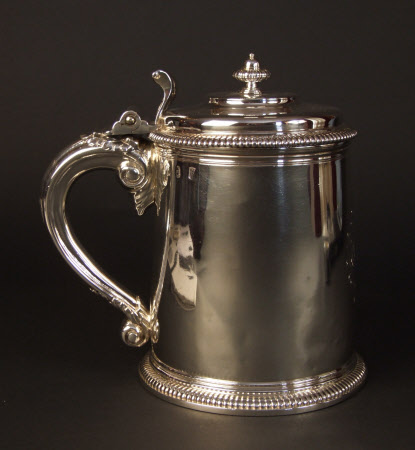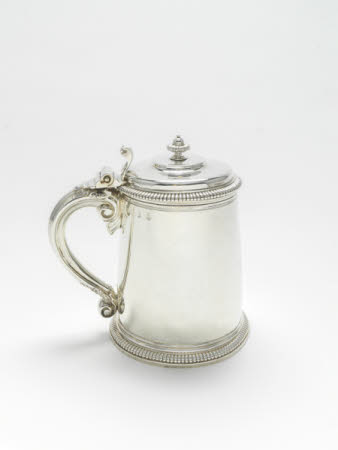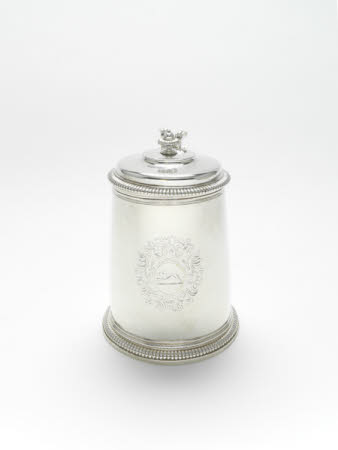Tankard
David Willaume (Metz 1658 - 1741)
Category
Silver
Date
1701 - 1702
Materials
silver
Measurements
20.5 x 14.5 x 18.5 cm; 42 tr oz
Place of origin
London
Order this imageCollection
Polesden Lacey, Surrey
NT 1246835
Summary
Tankard, Britannia silver, by David Willaume I (1658-1741), London, 1701/2. The tapering cylindrical body is raised and has applied cast mouldings at the rim and base, the latter consisting of bold gadrooning. Another cast gadrooned moulding encircles the stepped, domed lid which is also raised and terminates in a vase-shaped, gadrooned finial. The lid is attached to the handle by a pinned hinge and has a cast, scroll thumbpiece. The S-scroll handle, which is soldered to the body and is cast, has volute terminals enriched with acanthus leaf mouldings. The front of the tankard (opposite the handle) is engraved with an elaborate contemporary foliate cartouche, the central circular reserve containing a later crest. Heraldry: crest of a greyhound courant (running) collared, possibly for the Drury family. Hallmarks: on the side of the tankard below the rim, a full set consisting of maker’s mark ‘WI’ with two estoiles above and a fleur-de-lis below for David Willaume I [Arthur Grimwade, London Goldsmiths 1697-1837, 1990, no. 3192], Britannia, leopard’s head for London and date letter ‘f’ for 1701/2. Scratchweights: on base, '48' and '47-6'.
Full description
Lidded tankards with a large side-handle emerged in the 16th century and are associated only with beer-drinking, northern European countries. With its tapering cylindrical form, prominent S-scroll handle and hinged, stepped lid this tankard conforms to the standard for the late Stuart period in England. It is made distinct, however, by its bold and carefully judged castwork in the form of the gadrooned mouldings and the leaf and volute terminals to the handle. These contrast with, and are accentuated by, the plain, burnished surfaces and simple shapes of the base and lid. The tankard exudes the skilled and fashionable design-eye, in this case applied to an English model and shape, and the precise engineering and preference for a heavy gauge of metal which mark out the work of Huguenot goldsmiths. It is by one of the most important of these French immigrant makers, David Willaume I (1658-1741). By the time it was made he had been in London for over a decade and was well on his way to being one of the most successful retail goldsmiths of the first half of the eighteenth century. He already had some of the greatest aristocratic families as his patrons including the Dukes of Devonshire and Montagu and the Duchess of Somerset. For Montagu he had produced a double set of ‘Goodroonie [gadrooned] Fountains and Cestrons [cisterns]’ in 1700-01, essentially in the same aesthetic as the Polesden tankard but on a colossal scale.[1] Gadrooning, the most prominent feature of the Montagu pieces and the Polesden tankard, was highly fashionable in France from the 1670s and was one of the key features employed by Huguenot makers. Who the tankard was commissioned for is not known, the armorials having been changed and its early provenance not recorded, but its sophistication and substantial weight (originally 48 troy ounces) make it likely that it would have been someone of considerable wealth and up-to-the-minute fashion, albeit probably not noble as the cartouche does not allow for a coronet. The tankard forms part of the substantial and important collection of late 17th and early 18th century silver assembled in the first three decades of the 20th century by Dame Margaret Greville (1863-1942) for her London house, 16 Charles Street, Berkeley Square, and now preserved at Polesden Lacey.[2] 16 Charles Street had an enormous dining room and it was there that the Stuart silver would have been displayed at the glittering assemblies of political and society figures gathered for lunches and dinners. In 1930 the Daily Telegraph recorded, in an account of her entertaining, that ‘Mrs. Greville is very proud of her rare silver’ and in 1933 the News Chronicle noted, albeit incorrectly with regard to period, that the dining table was ‘laden with Georgian silver’. As with other elements of her collecting, Mrs Greville acquired pieces of silver that would impress through their quality and desirability individually but that could also form part of symmetrical arrangements. In the case of tankards she eventually had eight at her disposal. No details survive of how Mrs Greville acquired the tankard but it is likely that she did so, as with her pictures, through a dealer who perhaps sourced all her silver.[3] It was included in the sale of the collection of Sir Thomas Firbank (1850-1910), M.P. at Christie’s on 30th May 1904. In 1916 it was at Polesden Lacey and must have been transferred to 16 Charles Street thereafter. A near identical tankard was produced by Willaume the following year and was sold at Christie’s, New York, 23 October 2008, lot 229. James Rothwell, National Curator, Decorative Arts April 2022 NOTES: [1] Philippa Glanville, ‘Boughton Silver’, in Tessa Murdoch (ed.), Boughton House: The English Versailles, London 1992, p. 153. The fountains and cisterns survive at Boughton. A pair of more elaborately decorated ice pails of 1698/9 by Willaume for the 1st Duke of Devonshire are at Chatsworth. For the Duchess of Somerset’s patronage of Willaume see James Rothwell, ‘The Plate Bills of Lady Elizabeth Percy, Countess of Ogle and Duchess of Somerset, 1679-1719’, in Silver Studies, No. 37 (2021), pp. 5-29. [2] National Trust archive, Polesden Lacey, Probate inventory following the death of Dame Margaret Greville, 1943, p. 51. [3] A candidate is Lionel Crichton of Crichton Brothers, whose business was founded in 1889 and who advised the 10th Earl of Stamford on his silver purchases between the World Wars. For Lord Stamford’s patronage see James Rothwell, ‘ ‘A Plethora of Plates’: The re-assembly of the Warrington silver at Dunham Massey, Cheshire’, Apollo, April 2001, pp. 30-34.
Provenance
Sir Thomas Firbank (1850-1910), M.P.; his sale, Christie’s, 30 May 1904; acquired by Dame Margaret Greville (Margaret McEwan, the Hon. Mrs Ronald Greville) (1863-1942); at Polesden Lacey by 1916; recorded as having been at 16 Charles Street, Berkeley Square in the 1943 probate valuation following Mrs Greville’s death; bequeathed with Polesden Lacey to the National Trust in memory of Mrs Greville’s father, William McEwan (1827-1913).
Credit line
Polesden Lacey, the Greville Collection (National Trust)
Marks and inscriptions
Body of tankard, below rim: Hallmarks: full set consisting of maker’s mark ‘WI’ with two estoiles above and a fleur-de-lis below for David Willaume I [Arthur Grimwade, London Goldsmiths 1697-1837, 1990, no. 3192], Britannia, leopard’s head for London and date letter ‘f’ for 1701/2. Underside: Scratchweights: '48' and '47-6'.
Makers and roles
David Willaume (Metz 1658 - 1741), maker




